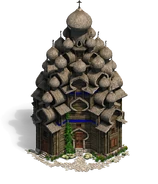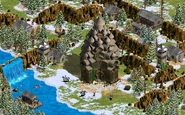| “ | While new kingdoms formed from the ruins of the Roman Empire in Western Europe, Slavic tribes settled the rich lands of Central and Eastern Europe and established formidable states of their own. Illuminate your populations with the teachings of Orthodoxy, recreate the rich farming and trade economies of Poland and Kievan Rus, assemble retinues of Boyars and Druzhina to defend the Russian principalities from the Mongols, or lead a charge of Winged Hussars to save Europe from Ottoman conquest! | ” |
| —Description | ||
The Slavs' civilization music theme in the Definitive Edition
The Slavs are an Eastern European civilization introduced in Age of Empires II HD: The Forgotten. They focus on infantry and siege weapons.
The Slavs represent their namesake based on the Eastern European peoples that later became the founders of Slavic European nations with a sphere of influence consisting of modern day Bulgaria, Poland, Russia, and Ukraine. By the time frame of Ages of Empires II, the Slavic tribes had already split into the Western, Eastern, and Southern branches.
The Slavic civilization is mostly representative of the Eastern Slavic identity of the Kievan Rus', whose semi-autonomous principalities and city-states covered much of modern-day Ukraine, Belarus, and Western Russia. Politics of the time were dominated by Boyar aristocracy, which was adapted into the Slavs' unique heavy cavalry unit.
Educated and influenced by the Byzantine Greeks as a result of its close proximity, they adopted the Eastern Orthodox branch of Christianity as their religion, and to depict this, their unique technology gives Monks extra armor. Slavic armies are mainly composed of infantry, and to depict this, their other unique technology gives infantry trample damage, making them powerful in groups and against clusters of units, and they also receive Supplies (Tracking before the Definitive Edition) for free.
Slavic lands in modern-day Ukraine were especially fertile and productive, later to be known as the Breadbasket of Europe, thus Slav Farmers receive a bonus. The Slavs have cheaper siege weapons and their team bonus provides +5 population to all military buildings, providing them a logistical military advantage in a similar fashion to the Byzantines, albeit in a more offensive way.
Overview
As an infantry civilization, the Slavs have access to the full infantry technology tree and also get Druzhina, making their infantry units highly useful in mass battles. Their cavalry is also good despite missing out on the Paladin upgrade. The archers, however, are among the worst of all civilizations. This is compensated to a degree by their excellent Siege Workshop units that get a 15% discount. Especially the Heavy Scorpion can fulfill the archers' role for the Slavs. Their navy is weak, although they can fully upgrade their Fire Ships. The Slavic Monks are excellent offensively with every upgrade there plus Orthodoxy which grants them extra armor, making them fearsome in Monk rushes. They lack Heresy and Faith and thus are vulnerable to conversion (Note: Faith was added in the Definitive Edition). Their defensive structures are below average but their faster farming is considered one of the strongest economic bonuses in the game.
Campaign appearances
The Slavs are a playable civilization only in a few scenarios of the Dracula campaign. They also appear as allies or enemies in:
Genghis Khan
- The Horde Rides West
- Russians (in the Definitive Edition)
- The Promise
- Polish (in the Definitive Edition)
Barbarossa
- Holy Roman Emperor
- Bohemia (in the Definitive Edition)
- Henry the Lion
- Poland (in the Definitive Edition)
Alaric
- All Roads Lead to a Besieged City
- Wenceslaus I
Battles of the Forgotten
- Honfoglalás
- Moravians
Tamerlane
- Harbinger of Destruction
- Ryazan
- Azov
Ivaylo
- A Most Unlikely Man
- Bolyars
- An Unlikely Alliance
- Ivan Asen
- Where the One-Eyed Man is King
- Radu Negru
Kotyan Khan
- Raising the Banners and The Battle at the Kalka River
- Kiev
- Galicia-Volhynia
Characteristics
Unique unit
 Boyar: Heavily armored cavalry, resistant to melee attack
Boyar: Heavily armored cavalry, resistant to melee attack
Unique technologies
 Orthodoxy: Gives Monks +3/+3 armor.
Orthodoxy: Gives Monks +3/+3 armor. Druzhina: Gives infantry splash damage.
Druzhina: Gives infantry splash damage.
Civilization bonuses
- Farmers work 10% faster.
- Supplies is free.
- Siege Workshop units are 15% cheaper.
Team bonus
- Military buildings (excluding Castles and Docks) provide +5 population.
Changelog
The Forgotten
- Boyars move at a speed of 1.35.
- Can research Treadmill Crane.
The African Kingdoms
- Initially can research Arrowslits. With patch 4.8, it was removed from the technology tree.
- With patch 4.8, Boyars now move at a speed of 1.4.
Rise of the Rajas
- The Farm bonus now properly works after researching Wheelbarrow and Hand Cart.
- With patch 5.8, the farm bonus was reduced back a slight amount so that it closely matches the stated 15% faster rate.
Definitive Edition
- Received Faith.
- Received free Supplies (instead of Tracking, since it was removed).
- Farmers work 10% faster (lowered from 15% faster).
- (Elite) Boyar training time reduced to 15s (from 23s/20s).
- With update 36906, the pierce armor of both standard and elite Boyar is increased by 1, and speed reduced to 1.3.
Lords of the West
- With Update 44725, Treadmill Crane removed from the technology tree.
In-game dialogue language
In-game, Slavic units speak Russian. Before Rise of the Rajas was released, Slavic units reused the Russians' dialogue that is used in Age of Empires III. With the expansion's release, they received new dialogue in Russian with a couple of archaic words, most notably аз (az) - an archaic form of pronoun "I".[1] Historically, East Slavs spoke a dialect continuum termed Old East Slavic.
- Select 1 Da? (Да?) - Yes?
- Select 2 Zdrav bud' (Здрав будь) - Greetings (literally - "Be well")
- Female Select 3 Az gotova (Аз готовa) - I'm ready (feminine)
- Male Select 3 Az gotov (Аз готов) - I'm ready (masculine)
- Select 4 Prikazaniya? (Приказания?) - Orders?
- Move 1 Da (Да) - Yes
- Move 2 Pravilno (Правильно) - Correct
- Move 3 Az sdelayu (Аз сделаю) - I'll do (it)
- Female Move 4 Male Move 5 Totchas sdelayu (Тотчас сделаю) - I'll do (it) immediately
- Male Move 4 Sdelayu (Сделаю) - I will do it
- Female Build Zizhditel'nitsa (Зиждительница) - Builder (feminine) (the verb зиждить / zížditʹ is an archaic / Old Church Slavonic word for "to build"[2][3])
- Male Build Zizhditel (Зиждитель) - Builder (masculine)
- Chop Lesorub (Лесоруб) - Woodcutter
- Female Farm Sobiratel'nitsa (Собирательница) - Gatherer (feminine)
- Male Farm Sobiratel (Собиратель) - Gatherer (masculine)
- Female Fish Rybachka (Рыбачка) - Fisherwoman
- Male Fish Rybak (Рыбак) - Fisherman
- Female Forage Sobiratel'nitsa (Собирательница) - Gatherer (feminine)
- Male Forage Sobiratel (Собиратель) - Gatherer (masculine)
- Female Hunt Okhotnitsa (Охотница) - Huntress
- Male Hunt Okhotnik (Охотник) - Hunter
- Mine Rudokop (Рудокоп) - Ore miner
- Female Repair Remontnitsa (Ремонтница) - Repairer (feminine)
- Male Repair Remontnik (Ремонтник) - Repairer (masculine)
- Military
- Select 1 Da? (Да?) - Yes?
- Select 2 K vashim uslugam (К вашим услугам) - At your service
- Select 3 Prikazaniya? (Приказания?) - Orders?
- Move 1 Ponyatno (Понятно) - Understand
- Move 2 Az sdelayu (Аз сделаю) - I'll do (it)
- Move 3 Da, gospodin (Да, господин) - Yes, my lord
- Attack 1 Ataka! (Атака!) - Attack!
- Attack 2 V boy! (В бой!) - To battle!
- Attack 3 K oruzhiyu! К оружию!) - To arms!
- Select 1 Da? (Да?) - Yes?
- Select 2 Prikazaniya? (Приказания?) - Orders?
- Select 3 K vashim uslugam (К вашим услугам) - At your service
- Select 4 Vo imya Gospodnya! (Во имя Господня!) - In the name of the Lord!
- Move 1 Az sobirayus' (Аз собираюсь) - I'm going to
- Move 2 Da (Да) - Yes
- Move 3 Ponyatno (Понятно) - It is clear
- Move 4 Totchas sdelayu (Тотчас сделаю) - I'll do (it) immediately
- Select 1 Vot, pozhaluysta (Вот, пожалуйста) - Here you are
- Select 2 Chto ty khochesh'? (Что ты хочешь?) - What do you want?
- Select 3 Pochemu ty pobespokoil mya? (Почему ты побеспокоил мя?) - Why did you bother me?
- Select 4 Opoveshcheniye (Оповещение) - Notification
- Move 1 Az sdelayu chto vam ugodno (Аз сделаю что вам угодно) - I'll do as you please
- Move 2 Po moyey milosti (По моей милости) - By my grace
- Move 3 Kak vy prikazali (Как вы приказали) - As you ordered
- Move 4 Az sdelayu (Аз сделаю) - I'll do (it)
AI player names
When playing a random map game against the computer, the player may encounter any of the following Slavic AI characters:
- Alexander Nevsky (Александр Невский): Served as Prince of Novgorod (1236–52), Grand Prince of Kiev (1236–52) and Grand Prince of Vladimir (1252–63) during some of the most difficult times in Kievan Rus' history: he defeated Swedish invaders in the north, the Livonian Order (landmasters of the Teutonic Order) in the west and made a peace with Mongolian conquerors in the east. He was later declared a saint by the Eastern Orthodox Church.
- Bolesław the Brave: Duke of Poland from 992 to 1025, and the first King of Poland in 1025. As Boleslav IV, he was also Duke of Bohemia between 1002 and 1003.
- Casimir II the Great: Possibly refers to Casimir II the Just (1138–1194), Duke of Cracow and senior prince of Poland, or Casimir III the Great reigned as the King of Poland from 1333 to 1370.
- Oleg the Seer (Ѡлегъ, Modern Russian: Олег Вещий): A Varangian prince (or konung) who ruled all or part of the Rus' people during the early 10th century.
- Ottokar I: Duke of Bohemia periodically beginning in 1192, then acquired the title King of Bohemia, first in 1198 from Philip of Swabia, later in 1203 from Otto IV of Brunswick and in 1212 from Frederick. He was a member of the Přemyslid dynasty.
- Rurik I (Рюрик I): Prince of Novgorod and Ladoga. He is the founder of Rurik Dynasty which ruled the Kievan Rus' and its successor states. He remained his power until his death in 879 in Novgorod, Kievan Rus.
- Sviatoslav the Brave (Свѧтославъ Игорєвичь): Also spelled Svyatoslav was a Grand prince of Kiev famous for his persistent campaigns in the east and south, which precipitated the collapse of two great powers of Eastern Europe, Khazaria and the First Bulgarian Empire.
- Vladimir the Great (Володимѣръ Свѧтославичь): A prince of Novgorod, grand prince of Kiev, and ruler of Kievan Rus' from 980 to 1015. He initiated a process of christening of Russia and got many glorifying names, including Vladimir the Christianizer (Креститель) and Vladimir the Scarlet Sun (Красно Солнышко)
- Wenceslaus I: Saint Wenceslaus I, Duke of Bohemia (907–935 or 929), and subject of a Christmas carol.
- Wenceslaus the One-Eyed: King of Bohemia from 1230 to 1253.
- Yaroslav the Wise (Яросла́в Му́дрый): Thrice grand prince of Veliky Novgorod and Kiev, uniting the two principalities for a time under his rule. During his reign, there was created the first Russian set of laws, "Russian Justice" ("Русская Правда").
- Yuri II (Юрий II): The fourth Grand Prince of Vladimir (1212–1216, 1218–1238) who presided over Vladimir-Suzdal at the time of the Mongol invasion of Russia.
Trivia
- The Slavs' civilization icon is based on the trident symbol from Yaroslav the Wise's era used by the Rurikids. This symbol is now used as the coat of arms of Ukraine.
- Before the Definitive Edition user interface image displayed double-headed eagle used by Grand Duchy of Moscow.
- Before the Forgotten was released, all of the Slav factions in the Genghis Khan and Barbarossa campaigns (Polish, Bohemians, and Russians) are mostly represented by Goths and Teutons.
- The in-game Slavs represented the pre-divisional Eastern Slavic identity of the Kievan Rus'. As this TedED video on the history of Russia explains, they were a people "populated by Slavs, ruled by Vikings, taught by Greeks, and split by Mongols, would develop differences in society, culture, and language that remain to the present day".
- Their unique unit, Boyar, was historically not found among West Slavs.
- Their unique tech, Orthodoxy, was also not found among the Catholic West Slavs.
- The Slavs were the second Russian-type civilization to be featured in the Age of Empires series, preceded by the Russians in Age of Empires III.
- Despite the fact that Castles are military buildings, they are not affected by the Slavic military building population bonus. This is most likely due to the fact that Castles already provide population.
- Some Slavic states like Kingdom of Bohemia, Grand Duchy of Moscow and Kingdom of Poland used gunpowder weapons quite often starting at the late 14th century and early 15th century (with notorious examples at the Great stand on the Ugra River where Ivan III deployed a good amount of cannons to defend against the last Tatar remnant of the Golden Horde and the Hussite Wars where arquebuses were highly used).
- However, for balance reasons, they don't have either Hand Cannoneer and Bombard Cannon.
- In the beta, the Slavs had access to Bracer, but lacked Plate Mail Armor. Also, their Eastern European building style was unique to them and looked different to later versions. They could not train Heavy Cavalry Archers or build Fortified Walls. Elite Boyars had 16 attack.
- Before the removal of Treadmill Crane, the Slavs were the most powerful civilization in Deathmatches.
Behind the scenes
During the development of The Conquerors, the Slavs (along with the Huns, Swiss, Magyars, and Habsburgs) had been considered to appear as the new civilization representing Eastern Europe. However, the Ensemble Studios team eventually picked the Huns because they were impressed by Attila story and the medieval Russians did very little of invading other countries when compared to the Huns.[4]
When the Forgotten Empires team was working on the Forgotten Empires mod (which eventually became The Forgotten), they initially planned to add the Scythians as one of the new civilizations. But eventually the plan was dropped because the Scythians were considered "too out of place" and they were replaced by Slavs.[5]
History
Mass fifth century migrations caused by the Hunnic invasions left northeastern Europe an area open for settlement and, starting circa 500 AD, the Slavs became the region’s dominant civilization. Although archaeological evidence indicates that the Slavs had already settled Europe in prior centuries, possibly in the areas of present-day Ukraine and Belarus, the historical record first makes mention of them through Byzantine writings describing the large numbers of Slavs massing near their borders. Upon settling down, the Slavs established several competing states throughout Eastern Europe, falling into either the Byzantine or Holy Roman spheres of influence.
The first great Slavic state, the Bulgarian Empire, formed in 681 AD. This nation was founded by the Bulgars, a Turkic people that settled in the Eastern Balkans (north of the Byzantine Empire). However, the Bulgarian Empire expanded into most of the Balkans, which was by then mainly Slavic, and by the tenth century the state was effectively Slavicized. The Bulgarian Empire played an important role in the consolidation of Slavic civilization, with its language becoming a lingua franca for the spread for Christianity and literacy in Eastern Europe.
Another important medieval Slavic state, Great Moravia, formed in Central Europe after the union of the Principalities of Nitra and Moravia in 833. Although Great Moravia never achieved a dominant position, it played a crucial role in the balance of power between the Franks, Bulgarians, and Byzantines. When King Ratislav of Great Moravia asked the Byzantines for help in translating Christian texts into Slavic, the Byzantine missionaries entrusted with the task, Cyril and Methodius, successfully developed the first Slavic alphabet and wrote down the oldest text in Slavic literature (a translation of the Christian Gospel) in 863.
Perhaps the last great medieval Slavic state was formed around Kiev, in present-day Ukraine, in 882 AD. This Kievan Rus’ kingdom, although mostly populated by Slavs, was led by Scandinavians (called Rus’) who took power in the area by defeating the ruling Turkic Khazars. The liberation of this and several other Slavic cities allowed them to focus more on internal development rather than on serving foreign lands. The region benefited economically from its geography, as it was located in the middle of the Europe-Asia trade route and close to the Byzantines and Persians. Under the reign of Yaroslav the Wise, the Kievan state not only became the largest of its time, but also achieved a high literacy rate, provided property rights to women, and punishments under law generally did not involve death sentences. However, the death of Yaroslav led to the gradual disintegration of the state, which finally fell to the Mongols by 1240 AD.
During the Middle Ages, Slavic governments followed a feudal system, but in contradiction to other parts of Europe the power of the kings was constrained by that of high-ranking aristocrats called boyars. Boyars not only were powerful landowners with several serfs under their command, but they also were generally leaders of the military and government agencies. The alliance and competition among these aristocrats shaped the economic development of the Slavic states, improving the vitality of their domains but weakening the central governments. By the Late Middle Ages, the rise of absolute monarchs led to the downfall of the boyars.





